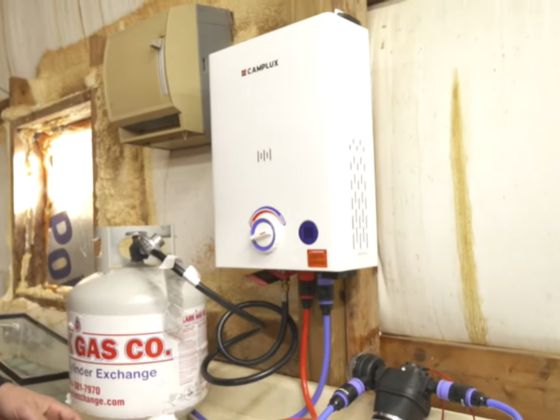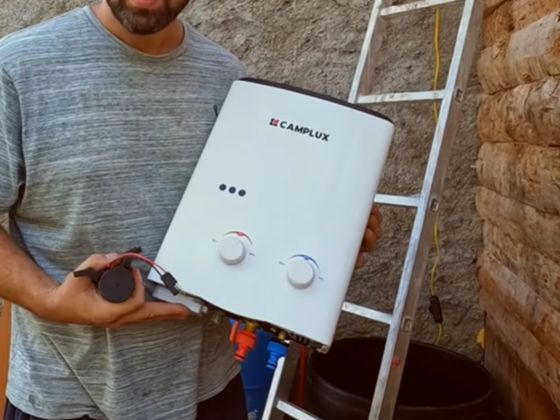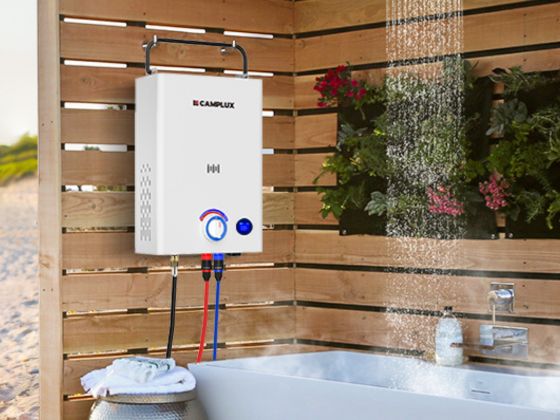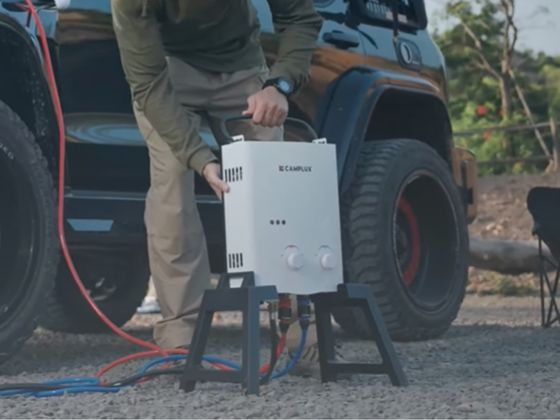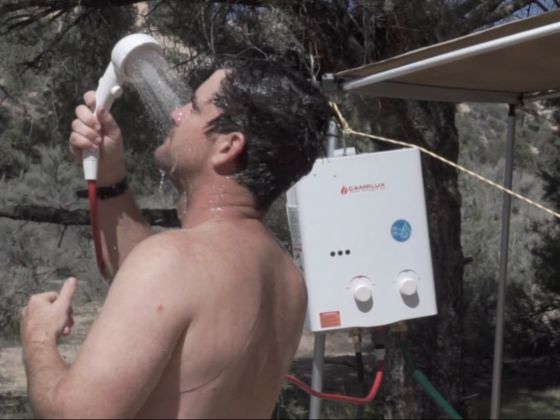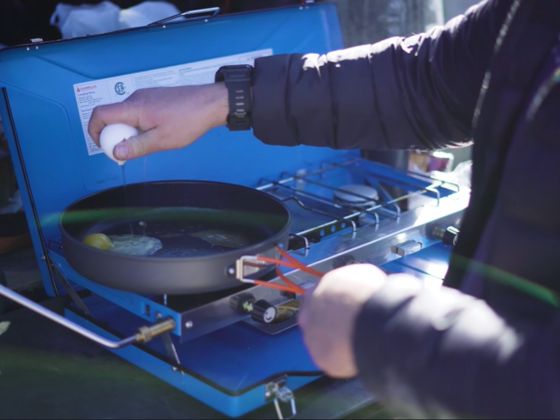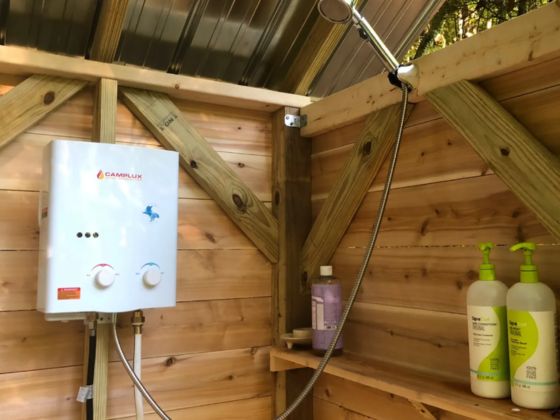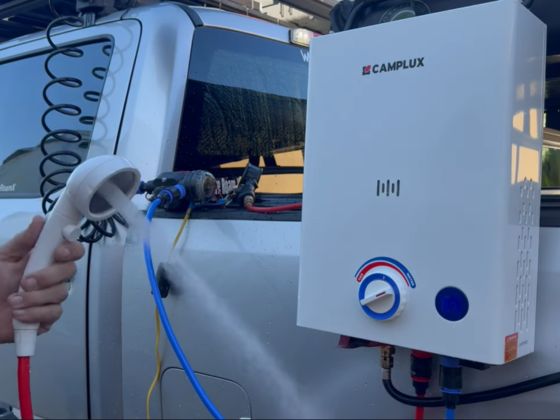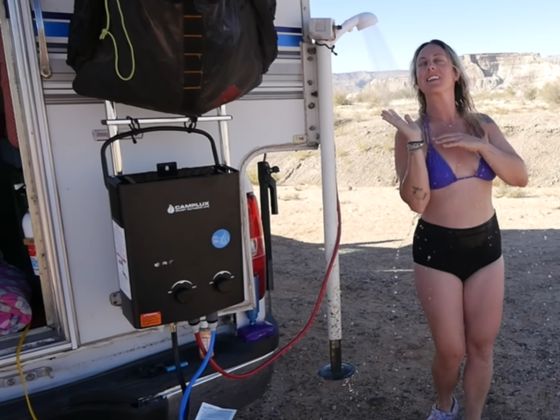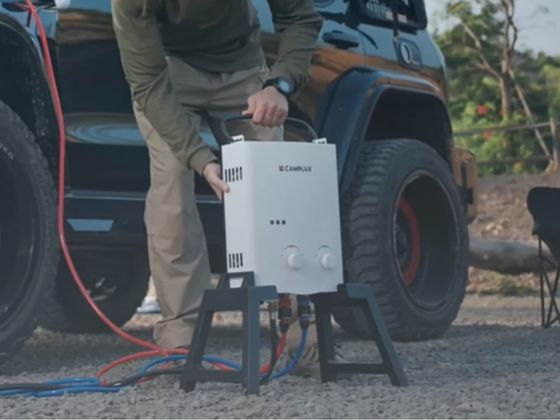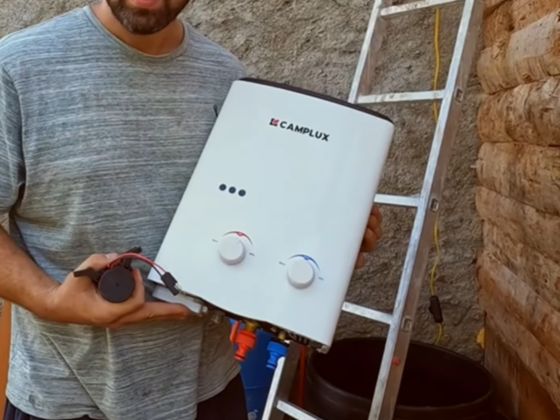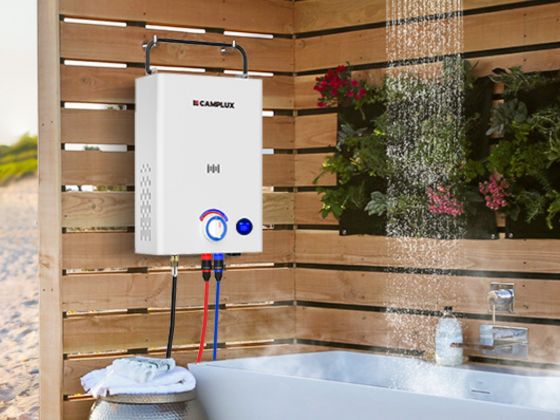Ending a day of exploring the outback or hiking with a steaming hot shower right at the campsite. With a portable camping hot water system like Camplux's, getting hot water is always easy. Get rid of showering in luke warm water from those solar shower bags – you should enjoy a hot shower in the wilderness, bringing home comfort to the great outdoors. This isn't just about cleanliness; it's about the convenience and comfort that turns rugged camping into a cozy experience.
Why You Need Hot Water in the Wild
As a beginner to camping, it might seem a little over to own a propane gas hot water heater, but the fact is that the portable hot water heater is a must. A portable hot water heater gives instant hot water so you can finish all the tasks in a flick: rinsing, showering, washing dishes, cleaning gear, or even giving your pet a warm bath. In remote campsites, an instant gas water heater means you don't have to sacrifice comfort or hygiene. It's like carrying a mini bathroom with just a carry bag! Even in places far off-grid, you can stay fresh and clean, turning camping into glamping with the simple addition of a hot shower.
Benefits of a camp hot water setup include: convenience (no need to hunt for public showers), better hygiene on multi-day trips, and morale – a warm rinse can do wonders for your mood outdoors. Whether you're tent camping or traveling in a caravan, a portable unit can act as your camper hot water heater, so you always end the day clean and comfortable.
Meet Camplux: Portable Camping Hot Water Systems
When it comes to camping portable hot water system solutions, Camplux is a popular choice in Australia. Camplux's range of propane-powered heaters are essentially outdoor LP tankless water heater units – meaning they run on LPG gas and heat water on-demand (no storage tank needed). They're designed with campers in mind: compact, lightweight, and easy to use. Here are some of the features and benefits that make Camplux stand out:
- Easy Setup: You can get a Camplux heater up and running in minutes. Just connect the gas supply, the water inlet hose, and the shower head, and you have a ready-to-go system. No electricity is required, so it's perfect for remote areas without power. (These heaters ignite with batteries, so you don't need a generator or mains power to enjoy hot water.)
- Truly Portable: The units are built to be carried and stored easily. For example, the Camplux 5L Portable Water Heater weighs only about 4.5 kg, and many models include handles or even a carry case for easy transport. It's a camper tankless hot water heater that you can sling in the back of your 4x4 or caravan without taking up much space.
- Instant, Unlimited Hot Water: Because it's tankless, a Camplux provides continuous hot water – as long as you have water and propane gas, you won't run out of hot water mid-shower. This on-demand heating is a game changer for extended trips or larger groups where everyone wants a turn for a warm shower. It truly functions as a camping hot water system that's always ready when you need it.
- Multi-Purpose Use: Beyond showering, your camping hot water system can be used for washing dishes, cleaning mud off boots, or even hosing down equipment. Camplux heaters come with showerhead attachments and flow control, so you can switch between a gentle shower spray or a stronger stream for cleaning gear. Having a propane camping shower heater setup means all your campsite hot water needs are covered in one device.
- Runs on Standard LPG Gas: Camplux portable heaters run on LPG (propane) from the same type of gas bottles you use for the BBQ. They include an Australian-standard gas regulator that hooks up to your gas cylinder. In other words, these devices are outdoor LPG water heater systems designed for Aussie conditions. A 4.5kg or 9kg gas bottle will fuel many showers. Always use the regulator and hose provided (they are AGA certified for safety), and you're good to go.
- Safety Certified: Camplux heaters are built with multiple safety features. For instance, they have overheat protection and flame failure shut-off. The units are AGA certified to meet Australian AS/NZS gas safety standards – giving you peace of mind that the outdoor LP tankless water heater is approved for use in Australia. (We'll cover safety tips in more detail later.)
Camplux offers models with different flow rates to suit your needs – commonly 5L, 8L, or 10L per minute capacity. The Camplux 5L Portable Tankless Water Heater is a favorite for most campers, delivering enough flow for a quick shower and sink duties. If you're camping with family or want higher pressure, the 8L or 10L models provide extra hot water output. Some packages even include extras like a 12V pump (for drawing water from a creek or jerry can) or a free-standing shower frame. There's a Camplux solution for everything from basic tent camping to use as a camper shower water heater mounted on a caravan or camper trailer.
Camplux 5L Portable Tankless Water Heater (with pump and shower attachment) is a compact unit perfect for camping, providing instant hot water anywhere you go. It's lightweight, runs on propane, and comes with everything you need for a camp shower heater setup.

How to Set Up Your Portable Camp Shower Heater
One of the best parts about Camplux and similar systems is that they're beginner-friendly. You don't need to be a plumber to get your camping portable hot water system working. Just follow these basic steps:
- Choose a Safe Setup Spot: Set your water heater up outdoors in a well-ventilated area, a few meters away from your tent or camper. Pick stable, level ground (or hang the unit from a secure mount) to keep it upright and dry. Avoid areas with strong winds if possible, as high winds could blow out the flame or affect performance. Also, keep it off the ground if you can – hanging the heater or elevating it on a table keeps the burner away from any gas that might settle low and protects it from splashes. Make sure the area around the unit is clear of any flammable materials.
- Connect the Gas Bottle: Always do this before turning anything on. Ensure your LPG gas bottle is closed (valve off) before connecting. Your Camplux heater comes with a gas hose and regulator that fit standard Aussie POL cylinders. Attach the regulator end into your gas bottle valve (remember, POL fittings screw in with a left-hand thread – opposite to normal) and tighten it firmly. Then connect the other end of the hose to the heater's gas inlet (usually a brass fitting under the unit). Hand-tighten, then give a slight additional turn with a spanner – do not over-tighten. Do not use Teflon tape on these connections; the provided rubber seals do the job, and tape can actually cause leaks. Once connected, open the gas valve slightly and perform a leak test: brush or spray soapy water around all connections and look for bubbles. If you see bubbling, you have a leak – turn off the gas, tighten the connection, and test again. No bubbles? Great – your gas hookup is sealed. (Never use a flame to check for leaks! Always use soapy water and watch for bubbles.) Keep the gas bottle upright and away from the heater itself, at least the length of the hose.
- Connect the Water Source: Next, hook up your water. You have two options: a garden hose from a tap, or a 12V pump drawing from a container. The heater's water inlet is usually a hose fitting (often ½ inch size) on the bottom of the unit. If you're at a campground with a tap, just attach your garden hose here (many kits include a quick-click hose connector for convenience). Don't turn on the water yet. If you're off-grid, you'll likely use the included pump: place the pump in your water jerry can or bucket, and connect its hose to the heater's inlet (Camplux pumps have an easy quick-connect that snaps into place). Ensure the pump is fully submerged so it primes properly, and have plenty of water on hand (a full jerry can) so you don't run dry mid-shower. Give all hose connections a tug to verify they're snug – a loose hose could pop off and spray water everywhere once pressure builds! If your heater has an inlet filter screen, make sure it's clean especially when using water from rivers or lakes (you don't want dirt clogging the system).
- Hook Up the Shower Hose: Attach the shower hose to the heater's water outlet (usually marked, often a red ring). This screws on similarly to the inlet hose – hand-tight should do if there's a rubber O-ring seal. Attach the shower head to the other end of the hose. Many camping shower heads have an on/off trigger – keep it in the "off" position for now. You can hang the shower head on a branch or a shower tent pole using the provided holder or a makeshift hook so it's ready for use and not lying in the dirt.
- Power and Ignite: Most portable gas heaters ignite automatically when water flows, using battery power for the spark. Install the required batteries into the unit (Camplux models typically use 2 x D-cell batteries in a compartment at the bottom/front). Double-check that all valves and switches on the unit are set to "ON" or the appropriate standby setting per the manual. Before lighting, do a final safety scan: confirm the area is clear of people and hazards, the gas bottle is a safe distance away, and nothing is inside a closed space (the heater itself must stay outside your tent or caravan – only the water hose should go into a shower tent). Now you're ready to fire up your camp shower heater! Open the gas valve on the bottle fully, then turn on your water flow. If using a tap, turn it on slowly; if using a pump, switch the pump on. In a second or two, the heater will sense the water flow and automatically ignite its burner (you might hear rapid clicking and a soft "whoomp" as the gas flame lights). Congrats – hot water is now coming out! 🎉
- Adjust Temperature and Enjoy: Check that the burner is lit – you'll usually hear it and maybe see a little flame through a viewport. Now adjust the water flow and gas knobs to get your ideal temperature. Remember: more gas = hotter water, while more water flow = cooler water (as it passes through the heater faster). Start with medium settings and tweak from there. Be cautious, as the water can get very hot on maximum settings – always test the water temperature with your hand before stepping under the shower. Once it's comfortable, hop in and enjoy your luxurious camp hot shower! Keep your showers relatively brief if water supply is limited, but otherwise relish the experience – you're officially camping with instant hot water.
- Turn Off and Pack Up: When you're done, turn off the water flow first, then shut off the gas valve. The burner will extinguish automatically as water stops. If you used a pump, switch it off. Let the unit cool down for a few minutes before handling it. It's good practice to disconnect the gas bottle and pack away the unit when not in use. Tip: In cold weather, open the drain plug (if your model has one) to empty any remaining water from the heater after use, so it doesn't freeze and damage the unit. Store the unit in a dry place until the next use. And that's it – setup and takedown are complete in a few easy steps!

Safety First: Using LPG Water Heaters in Australia
Using a gas appliance in the bush is safe and straightforward as long as you follow some basic safety and regulatory guidelines. Here are some essential tips specific to operating an outdoor LPG water heater in Australia:
- Outdoor Use Only: Always use your portable water heater outdoors in an open, well-ventilated area – never inside a tent, campervan, van annex, or any enclosed space. These devices produce exhaust (carbon monoxide), which must dissipate in fresh air. "Outdoor means outdoor," so even if you're using a shower tent or annex for privacy, keep the heater unit itself outside the tent (you can run the shower hose inside).
- Keep Clearances: Gas heaters have open flames, so give them space. Keep at least 0.5m clearance on all sides from tents, tarps, awnings, or any flammable materials. Also keep the unit a safe distance from any gas bottle or fuel source (usually the length of the gas hose provides enough separation). Never position the heater under a low roof or in a confined alcove – you want any heat and fumes to disperse upwards and away.
- Gas Bottle Safety: Only use LPG cylinders that are in good condition and within their test date. In Australia, refillable gas bottles must be re-tested every 10 years – check the date stamped on your bottle. Always transport and store gas bottles upright, and never lay a connected cylinder on its side during use. When the heater is not in use, turn off the gas bottle valve. If you smell gas at any time, shut off the bottle immediately and check your connections.
- Leak Checks and No Flames: We mentioned it in setup, but it bears repeating – whenever you connect a gas cylinder, perform a quick leak test with soapy water. Never use a naked flame to check for gas leaks. If you find a persistent leak you cannot fix by tightening, do not use the system until you replace the faulty part or get it serviced. It's also wise to keep any open flames (campfires, cigarettes, stoves) away from the heater and gas bottle while in operation.
- Use Certified Appliances: Make sure your portable water heater is certified for use in Australia. Camplux units, for example, carry Australian Gas Association (AGA) certification and comply with AS/NZS gas safety standards. Using a certified appliance ensures it has the proper safety features and is legal to operate. Avoid cheap import heaters that don't have Australian certification – they may not be safe or allowed.
- Follow the Instructions: Always read the manufacturer's manual for model-specific guidance. It will include info on proper operation, maintenance, and any additional safety features (such as over-temp sensors or tilt-switch cut-offs). Adhering to those instructions is key to safe use. Also, never modify the unit or its fittings – use it exactly as designed.
- Know the Regulations: If you are installing a water heater permanently (for instance, mounting on a caravan or cabin with a fixed gas line), Australian law requires a licensed gas fitter to do the installation. DIY is not allowed for fixed gas plumbing. The good news is that portable camp units don't require a license to set up and use, as long as you're just connecting a gas bottle and hose in a temporary manner. So you can set it up yourself at camp – just be diligent with safety. If in doubt, consult a professional or refer to Australian Standards (e.g. AS/NZS 5601 for gas installations).
- Stay Attentive: While using the shower, keep an eye (or ear) on the heater. It should run smoothly with a steady flame. If the flame goes out or you notice irregular operation, shut it off and investigate (low gas, low water, or high wind could be causes). Don't leave the unit running unattended. And of course, keep children and pets away from the hot unit and gas connections. A little vigilance goes a long way to prevent accidents.
By following these tips, you'll ensure your outdoor LPG water heater operates safely and within Aussie regulations. Always err on the side of caution – camping is about having fun, and that includes coming home safely after every trip!
Perfect Hot Showers: Where to Camp with No Worries
One of the big advantages of a portable camping hot water system is that it opens up a world of camping opportunities. You're no longer tied to campgrounds with facilities; you can venture to remote spots knowing you can still enjoy a hot wash each day. Here are a few popular Australian camping scenarios where a Camplux heater really shines:
- Outback Camps (No Amenities): Planning a trip across the Simpson Desert or camping in Sturt National Park near Cameron Corner? These places have breathtaking isolation – and zero amenities. Having your own camping shower heater means you can take a warm shower even when you're 200 km from the nearest town. For instance, at Dalhousie Springs in SA's Witjira National Park, the campground only offers cold bore water showers – but with a portable unit, you could end your day of outback driving with a hot shower under the stars. In the remote outback, a hot water heater turns "roughing it" into a much more comfortable adventure.
- Beachside Bush Camping: Australia has incredible coastal campsites that feel wild and remote. Think Cape York Peninsula in far north Queensland, or isolated beach camps in Western Australia (like in Cape Range or Francois Peron National Park). These spots often have no running water or showers, but with a propane heater, you can rinse off salt and sand with warm water at the day's end. Even on a surfing trip down the NSW/Vic coast, a camp shower heater set up next to your van means you don't have to stay salty overnight. Pack a popup privacy tent, and you have a beachside bathroom anywhere you go.
- Mountain and National Park Sites: Love camping in alpine or forest national parks? High-country sites in places like the Victorian Alps or Kosciuszko National Park are beautiful but basic. After a day of hiking or mountain biking, a hot shower is pure bliss – and it's yours to enjoy with a camping portable hot water system on hand. Similarly, in popular parks that lack shower blocks (e.g. some areas of the Blue Mountains or Flinders Ranges), you can be self-sufficient. You'll appreciate being able to wash off the sweat and dust, especially in colder mountain weather where a cold sponge bath is unappealing.
- Multi-day Off-Grid Adventures: Whether you're doing the Big Lap in a camper trailer or setting up a base camp for a week, having a camper shower water heater system gives you freedom. You can camp at that secluded riverbank or deep in the rainforest without worrying "how will we shower?" For RV and caravan users, a Camplux unit basically becomes your camper tankless hot water heater – you can mount it on an exterior hook when stationary, heat water on demand, and stow it away when moving. It's perfect for overlanders and tourers exploring Australia's remote tracks.
Wherever you go, make sure to bring enough gas and water for your hot water needs. A 9kg gas bottle can heat many showers (often dozens, depending on usage) and is usually more than enough for a week or two of camping. Water usage will be around 5–6 liters per minute of showering, so plan your water storage accordingly (or camp near a water source and filter/pump water as needed). With good planning, you can enjoy a hot shower in places most people wouldn't dream of – from the red deserts to the lush rainforests.
Stay Warm and Happy Camping!
Camping is all about adventure, but there's no rule that says you have to be uncomfortable. With a bit of gear like a portable water heater, you can have the best of both worlds: outdoor adventure and a touch of home comfort. For beginners, a product like Camplux makes it easy to set up a camping hot water system without stress, so you can focus on enjoying nature. Just imagine sipping a cuppa by the campfire, knowing a warm shower awaits you before bed – bliss!
Before your next trip, consider adding a Camplux camping hot water system to your checklist. The investment pays off on that first chilly night when you rinse off with perfectly heated water. Camplux offers everything from the compact 5L models to larger 10L units, so there's a solution for solo campers, families, and caravanners alike. These heaters are designed for Australian conditions, with safe and efficient LPG operation to give you instant hot water on tap.
Ready to upgrade your camping experience? Head over to the Camplux Australia site to explore the range of portable hot water heaters and find the perfect fit for your adventures. With the right camping instant hot water system in your arsenal, you'll never have to dread a cold camp shower again. Stay safe, enjoy the journey, and happy camping with your new hot water companion!

